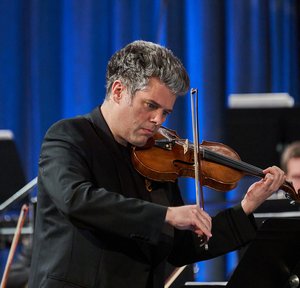Host of Mozart Day: Gábor Takács-Nagy
Liszt Academy, Grand Hall
MOZART: Sinfonia concertante for Violin, Viola and Orchestra in E-flat major K.364 (320d)
MOZART: Symphony No. 39 in E-flat Major, K.543
Featuring: Barnabás Kelemen violin, Katalin Kokas viola
Franz Liszt Chamber Orchestra (artistic director: István Várdai)
Conductor: Gábor Takács-Nagy

The "sinfonia concertante" was a popular genre of Mozart’s era, and as its name indicates, it is a mixture of a symphony and a concerto, marvelously combining their various features. Similarly, to Haydn, Mozart also exploited the modest ensemble without percussion instruments, or even flutes or Mozart’s beloved clarinets; on the other hand, he splits the violas to achieve a richer string sound. Many believe that the Sinfonia Concertante in E-flat major (KV 364) is Mozart's greatest "violin concerto", superseding his five "official" violin concertos. Still, the viola's role is by no means secondary in this work; the choice of the second solo instrument is very telling: even though Mozart himself was an excellent violinist himself, he enjoyed playing the viola in string quartet formations since – just like J.S. Bach – he loved sitting in the middle of harmonies. In the original score, Mozart wrote the viola part in D major, and thus, the violist was forced to tune his strings a semitone higher, which, due to their tightness, lends the viola a brighter sound and balances the violin’s usual limelight-like resonance and presence. The remarkable cooperation of the two soloists, as well as their captivatingly beautiful sonority, render Mozart's masterpiece unforgettable. It is not the first time the audience has had the opportunity to relish the unique musical harmony between the couple Barnabás Kelemen and Katalin Kokas during the performance of this singular work of Mozart’s, featuring this time the Franz Liszt Chamber Orchestra.
Myths and reality often contradict each other when we take a look at the last phase of Mozart's painfully brief life. He wrote his last three symphonies in E-flat major (KV 543), in G minor (KV 550) and C major (KV 551) at the age of 32, in the summer of 1788. In his letters referring to his financial constraints, he mentions these works as a kind of "token" in exchange for loans. Although legend has it that Mozart didn’t live to enjoy the premieres of these symphonies, there is no evidence supporting it. The legends regarding the impact his late works had on the audience of the day, however, prove to be true, as they set a challenge both for their listeners and their performers. Especially his final symphonies diverged radically from the convention: while our concept of a symphony begins with Beethoven, and, therefore, we have a profound and monumental piece in our mind's eyes, Mozart's audience expected a symphony to be relatively short and light. His Symphony in E-flat major (KV 543), using clarinets instead of the conventional oboes at the time, with its grandiose overture and finale processing a single theme in several variations –an unusual method for the composer – promises a tremendous musical experience in the interpretation of the Franz Liszt Chamber Orchestra under Gábor Takács-Nagy’s baton.
